Discovering cat pee on your mattress is frustrating. Cat urine not only leaves an unpleasant odor but also stubborn stains that can be difficult to remove. The key to successfully getting cat pee out of a mattress is to act quickly. The longer you wait, the deeper the urine penetrates, making removal and odor elimination much harder.
Why is cat urine so challenging to remove from mattresses? It’s due to uric acid crystals, which are not water-soluble. This makes cat urine different from many other liquids and requires specific cleaning methods to break down and eliminate effectively. Furthermore, the ammonia in cat urine contributes to its strong, lingering smell.
If your feline friend has repeatedly used your mattress as a litter box, and you’re struggling to eliminate persistent stains and odors, it might be time to consider a new mattress. For those looking to upgrade, explore our guide to the best mattresses of the year, featuring options for every sleeper and budget. You might even find discounted options during seasonal sales events.
However, before you consider replacing your mattress, let’s walk through proven methods on how to get cat urine out of a mattress effectively, tackling fresh pee, stubborn stains, and lingering odors.
How to Remove Fresh Cat Urine from a Mattress
For fresh cat urine, immediate action is crucial. Here’s what you need:
Products you’ll need:
- Clean paper towels or absorbent cloths
- Vacuum cleaner with upholstery attachment
- Baking soda
- Enzyme cleaner
Step 1: Absorb the Urine Immediately
As soon as you spot cat urine on your mattress, grab clean paper towels or an absorbent cloth. Blot the area firmly to soak up as much urine as possible. Avoid rubbing, as this can spread the urine and push it deeper into the mattress fibers. Continue blotting, using fresh paper towels or a clean section of cloth each time, until you are no longer absorbing liquid.
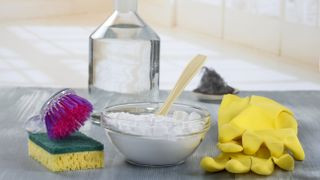 how to clean a mattress: baking soda, vinegar, sponge and gloves
how to clean a mattress: baking soda, vinegar, sponge and gloves
Alt text: Mattress cleaning supplies including baking soda, vinegar, sponge, and gloves arranged on a mattress, illustrating tools for removing cat urine.
Step 2: Apply Baking Soda Generously
Baking soda is a natural odor neutralizer and moisture absorber, making it ideal for drawing out any remaining cat urine from the mattress. It also works to combat the potent ammonia smell associated with cat pee. Sprinkle a thick layer of baking soda over the affected area, ensuring complete coverage. Let the baking soda sit for several hours, or even overnight, for maximum absorption and deodorizing effect. The longer it sits, the more effective it will be in drawing out moisture and odor.
Step 3: Vacuum Thoroughly
Once the baking soda has sat and absorbed the urine, use a vacuum cleaner with an upholstery attachment to remove it. Vacuum the area thoroughly, going over it multiple times to ensure all traces of baking soda are removed. To prevent any lingering odors from recirculating, it’s advisable to empty your vacuum cleaner canister or bag immediately after cleaning, preferably into an outdoor trash bin. Cleaning the vacuum components can also help prevent odor retention.
Step 4: Utilize an Enzyme Cleaner
While baking soda helps neutralize odors, an enzyme cleaner is specifically formulated to break down the uric acid in cat urine. This is crucial for complete odor removal, as cats have a keen sense of smell and can detect even faint traces of urine. If the urine scent lingers, your cat might be tempted to urinate in the same spot again. Enzyme cleaners eliminate the urine at a molecular level, removing the odor that attracts cats back to the area. Apply the enzyme cleaner according to the product instructions, usually by spraying or blotting it onto the affected area.
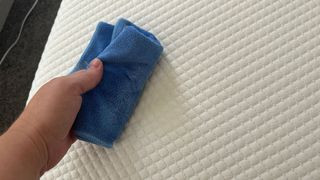 Blotting enyze cleaner to get cat urine out of a white mattress
Blotting enyze cleaner to get cat urine out of a white mattress
Alt text: Applying enzyme cleaner to a white mattress to remove cat urine stain by blotting with a cloth, demonstrating a step in mattress cleaning process.
Step 5: Blot and Air Dry Completely
After applying the enzyme cleaner, gently blot the area again with a clean paper towel or cloth to remove any excess cleaner. Allow the mattress to air dry completely before remaking your bed with sheets. Ensure it’s fully dry to prevent moisture buildup and potential mold growth. Good air circulation in the room can help speed up the drying process.
How to Get Cat Pee Stains Out of Your Mattress
If you’re dealing with set-in cat urine stains, a slightly different approach is needed. Here’s how to tackle those stubborn marks:
Products you’ll need:
- Clean spray bottle
- White vinegar
- Cold water
- Baking soda
- Clean cloths
Step 1: Prepare a Vinegar Solution
Vinegar is a natural cleaning agent and deodorizer. Create a cleaning solution by mixing equal parts white vinegar and cold water in a spray bottle. Lightly mist the stained area with the vinegar solution. Be careful not to oversaturate the mattress, as excessive moisture can damage the mattress and lead to mold. The acidity of the vinegar helps to break down the stain and also acts as a mild disinfectant, killing bacteria that may be present in the urine. Cold water is recommended as hot water can set the stain further.
Step 2: Apply a Baking Soda Paste
Create a paste by mixing baking soda with a small amount of water in a bowl. The consistency should be thick enough to apply to the stain. Apply a generous layer of this baking soda paste over the cat urine stain. Let the paste sit for several hours, or ideally overnight. The baking soda will work to draw out the stain and any lingering odors. Again, the longer you leave it, the more effective it will be.
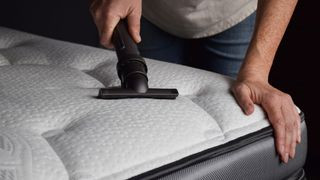 A person uses a handheld vacuum cleaner to vacuum a corner of a mattress
A person uses a handheld vacuum cleaner to vacuum a corner of a mattress
Alt text: Vacuuming baking soda paste from a mattress corner with a handheld vacuum cleaner after stain treatment, showing mattress cleaning in progress.
Step 3: Vacuum and Air Dry
Once the baking soda paste has dried and become crumbly, vacuum it up thoroughly using your vacuum cleaner’s upholstery attachment. Ensure all residue is removed from the mattress surface. Allow the mattress to air dry completely. This may take a few hours, depending on the humidity and airflow in the room.
Step 4: Repeat if Necessary
For stubborn stains or if a faint stain persists, repeat the vinegar solution and baking soda paste steps. You may need to apply the treatment a couple of times to see noticeable stain lifting. Once the stain is significantly reduced or removed, repeat all steps one last time to ensure complete cleaning and odor removal.
How to Get Cat Pee Odor Out of Your Mattress
Even after removing urine and stains, the odor can sometimes linger. Here’s how to specifically target and eliminate cat pee odor from your mattress:
Products you’ll need:
- Rubbing alcohol (isopropyl alcohol)
- Clean spray bottle
- Enzyme cleaner
- Baking soda
- Essential oils (optional, use with caution around cats)
Step 1: Apply Rubbing Alcohol
Rubbing alcohol is effective in neutralizing the ammonia in cat urine and it evaporates quickly, which is beneficial for mattress cleaning as it minimizes moisture exposure. Pour rubbing alcohol into a spray bottle and lightly spritz the affected area of the mattress. Allow it to air dry completely. However, be cautious when using rubbing alcohol, especially on memory foam or latex mattresses, as it can potentially damage these materials. Always perform a patch test in an inconspicuous area first to ensure it doesn’t cause discoloration or damage.
Step 2: Add Baking Soda with Optional Essential Oils
After the rubbing alcohol has dried, vacuum the area to remove any residue. Then, apply a generous layer of baking soda over the area to absorb any remaining odors. For an added fresh scent, you can mix a few drops of cat-safe essential oils with the baking soda before sprinkling it on the mattress. Safe options include lavender or chamomile. However, it’s crucial to avoid essential oils that are toxic to cats, such as citrus oils, peppermint, pine, eucalyptus, and tea tree oil. Always research and ensure any essential oil used is safe for a pet environment.
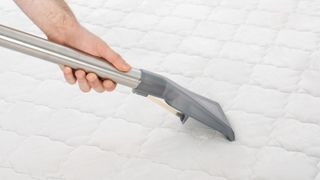 Vacuum cleaning a white mattress to get rid out baking soda used to neutralize cat urine odors
Vacuum cleaning a white mattress to get rid out baking soda used to neutralize cat urine odors
Alt text: Vacuuming baking soda from a white mattress to remove cat urine odors, demonstrating odor elimination step in mattress care.
Step 3: Let it Sit and Vacuum
Allow the baking soda to sit on the mattress for at least four hours, or longer if possible. The extended contact time allows for maximum odor absorption. Once sufficient time has passed, vacuum the baking soda thoroughly, ensuring all traces are removed. You may want to vacuum the area multiple times to ensure complete removal.
Step 4: Use Enzyme Cleaner if Needed
If a cat urine odor persists after these steps, a high-quality enzyme cleaner is your best solution. Enzyme cleaners are designed to break down the uric acid crystals that cause the odor, effectively eliminating the source of the smell. Apply an enzyme cleaner as a final step, following the product instructions. Many enzyme cleaners also contain odor-neutralizing agents for enhanced odor control.
How to Stop Your Cat from Peeing on Your Bed
Cleaning cat pee from your mattress is just one part of the problem. Preventing future accidents is equally important. Here are some steps to deter your cat from using your bed as a toilet:
- Wash Bedding with Enzyme Cleaner: Wash all bedding, including sheets, blankets, and mattress protectors, using an enzyme cleaner and laundry detergent. This removes any residual urine scent that might attract your cat back to the same spot.
- Rule Out Medical Issues: Consult with your veterinarian to rule out any underlying medical conditions that might be causing your cat to urinate outside the litter box. Urinary tract infections or kidney problems can sometimes lead to accidents.
- Litter Box Management: Ensure your cat’s litter box is clean, easily accessible, and located in a private area. Cats are sensitive to litter box hygiene, and a dirty or inconvenient litter box can lead to them seeking alternative places to eliminate.
- Restrict Bedroom Access: If your cat tends to pee on the bed when you’re not home, consider restricting their access to the bedroom when you’re away.
- Use Deterrents:
- Foil or Plastic Sheeting: Cover your bed with foil or plastic sheeting, as many cats dislike the texture and sound of these materials.
- Citrus Scents: Cats generally dislike citrus smells. Use a citrus-scented air freshener or place cotton balls soaked in diluted citrus oil (away from direct cat contact) near the bed to deter them. Be extremely cautious with citrus oils as they are toxic to cats if ingested.
- Feliway Diffusers and Repellents: Consider using a Feliway Diffuser, which releases calming pheromones to reduce stress and anxiety in cats, potentially reducing behavioral issues like inappropriate urination. You can also try cat repellent sprays, ensuring they are safe for use on bedding and testing on a small area first.
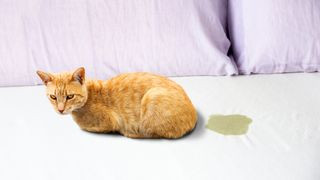 Ginger cat sits next to a pool of urine on a mattress
Ginger cat sits next to a pool of urine on a mattress
Alt text: Ginger cat sitting beside a pool of urine on a mattress, illustrating the problem of cat urination outside the litter box.
How to Co-Sleep with Your Cat and Protect Your Mattress
If you enjoy co-sleeping with your cat but want to protect your mattress from accidents and allergens, consider these tips:
- Invest in a Waterproof Mattress Protector: A high-quality waterproof mattress protector is essential. It will prevent spills, accidents, and allergens from penetrating your mattress. Look for hypoallergenic options to minimize allergens and skin irritations.
- Choose Machine-Washable Protectors: Opt for mattress protectors that are machine washable for easy cleaning and hygiene maintenance. Regular washing keeps them fresh and reduces allergen buildup.
- Regular Cleaning Routine:
- Wash Bed Sheets Weekly: Wash your bed sheets at least once a week in warm water to remove dead skin cells, pet dander, and allergens.
- Wash Pillows Regularly: Don’t forget to wash your pillows regularly to keep your entire sleep surface clean and hygienic.
- Vacuum Mattress Regularly: Get into the habit of vacuuming your mattress surface regularly to remove dirt, debris, and pet hair.
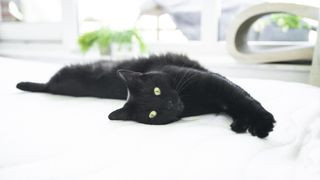 Black cat relaxing on a white mattress
Black cat relaxing on a white mattress
Alt text: Black cat peacefully relaxing on a white mattress, illustrating co-sleeping with pets and the need for mattress protection.
By acting fast, using the right cleaning methods, and taking preventative measures, you can effectively get cat pee out of your mattress and keep it fresh and clean, even with feline companions sharing your sleep space.
